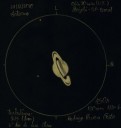Object Name: Saturn, Titan (T), Iapetus (J), Dione (D) and Rhea (R)
First Sketch:
CM1317,8º / CM2184,7º / CM3 319,1º
Rings: B = 10º
Location: Itajobi, SP, Brazil (backyard, downtown)
W49º03′ / S21º19′ / +460m
Date: December 27, 2010 – 06h30min (U.T.)
Seeing: 5/5 (Great!)
Telescope: reflecting 180mm / 1080mm (f6) dob mounted
Eyepieces: SP 32mm; SP 10mm; SP 6mm; 2,5x Barlow. No filter employed.
Media: graphite pencil on white paper, scanned then inverted and colors edited
Observer: Rodrigo Pasiani Costa
I spent that whole night observing the sky from backyard, and one of my targets was Saturn. Despite the clouds, the seeing and transparency were great, so I could see Saturn like never before (450x without any loss). Both the shadows of the rings on the globe and the shadows of the globe over the rings were clearly seen, splitting one another. The Cassini Division could be seen in both ends of the rings, but the difference in the outer ring color was not notable. A dark stripe crossed the planet, fading yet very remarkable. Another shy dark stripe intended to follow the first one, however was not able to cross the hole bright disc. Two of its moons were visible. In fact, Iapetus was probably visible too, however it was far away from the planet, and I missed it.
The next night it rained a lot, and I spent it doing something else. The following three nights the sky was clear again, and I could observe Saturn and its moons. I made this four sketches (in second picture) to show the dance of the moons around Saturn, all made at the same hour, during four days. Follow the sequence:
a) December 27, 2010
b) December 29, 2010
c) December 30, 2010
d) December 31, 2010
I hope you enjoy it, it was really pleasant to observe Saturn last summer.
Rodrigo Pasiani Costa



very nice sketch.
i enjoyed it…
Excellent series!
Rodrigo,
This is a very realistic sequence of sketches of Saturn and its moons from the typical observing location that most of humanity has.
I am very impressed with your beautiful work here.
Frank 🙂
Thanks a lot, friends!
Researching about the central meridian coordinates, I’ve just discovered that the interruption in the “shy” dark stripe (in the first sketch) was probably due to the white storm. That was a huge surprise to me, cause I was unaware of it that night.